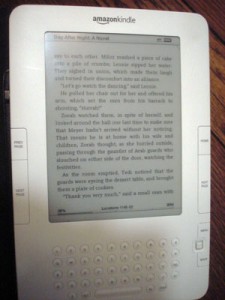E-READERS: So easy a caveman can read it
Vivian Volirakis
The Signal Staff
From the beginning of time, man has searched for ways to communicate messages that will leave behind a permanent mark.
In the Stone Age, Neanderthals scratched pictures with a sharpened rock onto the walls of their cave dwellings. Mesopotamians carved simple objects and pictures onto wet clay tablets with reeds and baked them in the sun.
Egyptian scribes used hieroglyphics, a series of picture words, on buildings and tombs and kept records of events on papyrus. Phoenicians replaced drawings with symbols, creating the first alphabet that represented sounds.
When German inventor Johannes Gutenberg invented the printing press in 1440, books and literature could be produced on a mass scale.
Fast-forward to 2007, when Amazon launched its e-book reader, the Kindle. Electronic readers allow people to consolidate print book collections into digital files by downloading e-books onto the digital device. Communication has come a long way since the Stone Age.

Amazon’s Kindle
The Kindle wirelessly downloads books, magazines, newspapers and personal documents onto a high-resolution portable screen display that mimics genuine paper. The reading device uses the same 3G wireless networks that many cell phones use, eliminating the hunt for Wi-Fi hotspots.
The wireless device is also unbelievably portable, unlike textbooks that can weigh up to four pounds. Amazon’s Kindle is .36” thick and weighs just over 10 ounces, much lighter than an average paperback book.
With 2 GB of memory, the Kindle can store up to 1,500 books, and each book takes less than 60 seconds to download. Slow readers should have no worries since the Kindle’s battery power can last up to two weeks with the wireless setting turned off and about four days with the wireless setting on.
Since the launch of Sony’s e-reader in 2006, Amazon and other electronic companies are making their best effort to keep up with the e-reader trend. This June, Samsung launched the Papyrus in Korea and China with possible plans of launching the product in the U.S.
“We are still looking at this market and would like to launch something early next year…stay tuned,” said Jason Redmund, senior manager of strategic marketing for Samsung electronics of America.
E-readers could become a solution to improve the environment and take the strain off of college students’ backs both physically and financially with prices around $259, comparable to the cost of one average textbook and downloads around $5 each.
Kindles will not be found in a pile of trash or at a ‘half-price-Kindle’ store like books and other printed materials. Unlike paper books, publications downloaded to e-readers can simply be deleted rather than ending up as pollution in a landfill.
Currently, the Kindle store offers more than 350,000 books, including textbooks, in their e-library available for downloading plus top newspapers, magazines and blogs. Amazon’s vision for Kindle is to offer every book ever printed, in any language, in less than 60 seconds.
There are extra perks to owning an e-reader. Several of the digital devices allow readers to choose a larger font and magnify the screen for those who have vision problems. Many of the most recently released e-readers have bookmark, highlight and touch screen keyboard text features.
“I think it is great,” said literature major Naomi Gonzales. “It is still cheaper to get a Kindle for the cost of one text book, especially if you are at the beginning of your college career. It is actually on my Christmas wish list.”
While it sounds like students’ dreams have come true, e-readers may lack some of the qualities that original books and textbooks offer. Sometimes the low-tech simple way of doing things is best. E-readers are built to read like paper without a glare, but are they still lacking a personal touch? You cannot highlight, post sticky notes, flag pages nor scribble in the margins on an e-reader: conveniences that readers are accustomed to with traditional paper pages.
Not to mention, the ability to hold a special edition hard bound book in the palm of one’s hands would become obsolete, home libraries would become a waste of space and Sunday afternoons spent drinking coffee and rummaging through book shelves in Barnes & Noble would become a dying habit if we scrapped the “old fashioned” way of reading.
Instead of shelves lined with books and bedtime stories read by a roaring fireplace, home libraries would transform into the cold, sterile environment forewarned in Fahrenheit 451.
“If I am buying a book I really care about, I would still buy the hard copy,” Gonzales said. “As a lit major I get most of my books from Half Price Books.”
As e-readers eventually become more popular, will financial aid keep up with the growing technological trend? Financial aid is distributed to students as a lump sum so students can decipher which categories need the most financial assistance, whether it is for tuition, housing, books or materials.
“When we budget financial aid for students, we assume what it will cost for a student to go to school and we factor in the cost of books and supplies so that students can use the funds with their own discretion,” said Billy Satterfield, interim executive director of student financial aid. “I do not see any reason why financial aid would not continue to provide students with the materials necessary to use for their education.”
E-readers are a major leap in the way our world communicates. Once again, they have left us standing at the crossroads of the information highway. Just like the way society was impacted by the launch of the printing press, telephone, radio, television and the Internet, e-readers have the same potential to alter how society functions. For better or for worse, e-readers are here.


Comments are closed, but trackbacks and pingbacks are open.